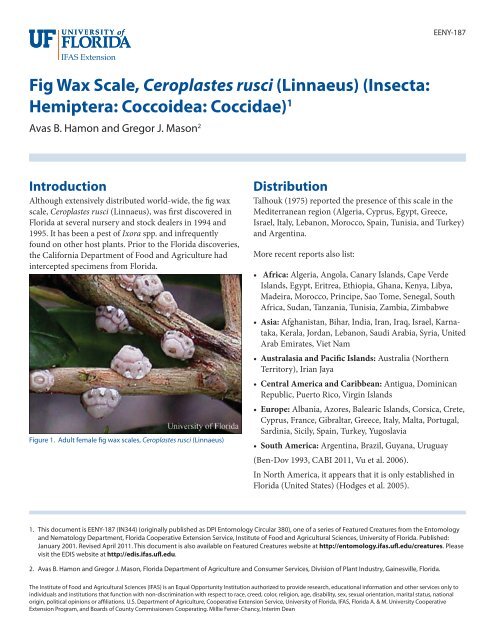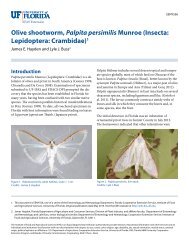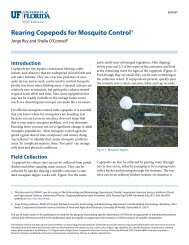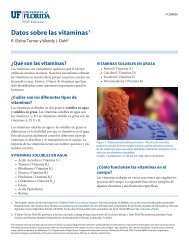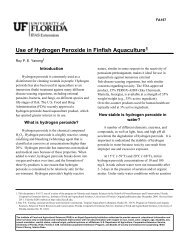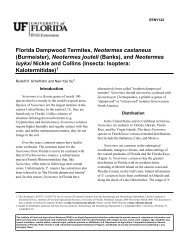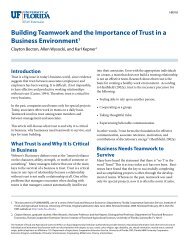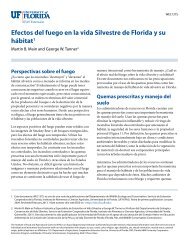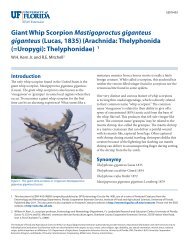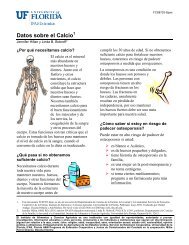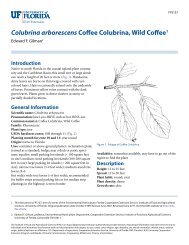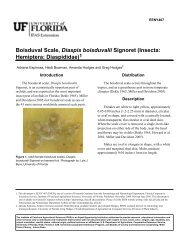Fig Wax Scale, Ceroplastes rusci - EDIS - University of Florida
Fig Wax Scale, Ceroplastes rusci - EDIS - University of Florida
Fig Wax Scale, Ceroplastes rusci - EDIS - University of Florida
You also want an ePaper? Increase the reach of your titles
YUMPU automatically turns print PDFs into web optimized ePapers that Google loves.
<strong>Fig</strong> <strong>Wax</strong> <strong>Scale</strong>, <strong>Ceroplastes</strong> <strong>rusci</strong> (Linnaeus) (Insecta:<br />
Hemiptera: Coccoidea: Coccidae) 1<br />
Avas B. Hamon and Gregor J. Mason 2<br />
Introduction<br />
Although extensively distributed world-wide, the fi g wax<br />
scale, <strong>Ceroplastes</strong> <strong>rusci</strong> (Linnaeus), was fi rst discovered in<br />
<strong>Florida</strong> at several nursery and stock dealers in 1994 and<br />
1995. It has been a pest <strong>of</strong> Ixora spp. and infrequently<br />
found on other host plants. Prior to the <strong>Florida</strong> discoveries,<br />
the California Department <strong>of</strong> Food and Agriculture had<br />
intercepted specimens from <strong>Florida</strong>.<br />
<strong>Fig</strong>ure 1. Adult female fi g wax scales, <strong>Ceroplastes</strong> <strong>rusci</strong> (Linnaeus)<br />
EENY-187<br />
Distribution<br />
Talhouk (1975) reported the presence <strong>of</strong> this scale in the<br />
Mediterranean region (Algeria, Cyprus, Egypt, Greece,<br />
Israel, Italy, Lebanon, Morocco, Spain, Tunisia, and Turkey)<br />
and Argentina.<br />
More recent reports also list:<br />
• Africa: Algeria, Angola, Canary Islands, Cape Verde<br />
Islands, Egypt, Eritrea, Ethiopia, Ghana, Kenya, Libya,<br />
Madeira, Morocco, Principe, Sao Tome, Senegal, South<br />
Africa, Sudan, Tanzania, Tunisia, Zambia, Zimbabwe<br />
• Asia: Afghanistan, Bihar, India, Iran, Iraq, Israel, Karnataka,<br />
Kerala, Jordan, Lebanon, Saudi Arabia, Syria, United<br />
Arab Emirates, Viet Nam<br />
• Australasia and Pacifi c Islands: Australia (Northern<br />
Territory), Irian Jaya<br />
• Central America and Caribbean: Antigua, Dominican<br />
Republic, Puerto Rico, Virgin Islands<br />
• Europe: Albania, Azores, Balearic Islands, Corsica, Crete,<br />
Cyprus, France, Gibraltar, Greece, Italy, Malta, Portugal,<br />
Sardinia, Sicily, Spain, Turkey, Yugoslavia<br />
• South America: Argentina, Brazil, Guyana, Uruguay<br />
(Ben-Dov 1993, CABI 2011, Vu et al. 2006).<br />
In North America, it appears that it is only established in<br />
<strong>Florida</strong> (United States) (Hodges et al. 2005).<br />
1. This document is EENY-187 (IN344) (originally published as DPI Entomology Circular 380), one <strong>of</strong> a series <strong>of</strong> Featured Creatures from the Entomology<br />
and Nematology Department, <strong>Florida</strong> Cooperative Extension Service, Institute <strong>of</strong> Food and Agricultural Sciences, <strong>University</strong> <strong>of</strong> <strong>Florida</strong>. Published:<br />
January 2001. Revised April 2011. This document is also available on Featured Creatures website at http://entomology.ifas.ufl .edu/creatures. Please<br />
visit the <strong>EDIS</strong> website at http://edis.ifas.ufl .edu.<br />
2. Avas B. Hamon and Gregor J. Mason, <strong>Florida</strong> Department <strong>of</strong> Agriculture and Consumer Services, Division <strong>of</strong> Plant Industry, Gainesville, <strong>Florida</strong>.<br />
The Institute <strong>of</strong> Food and Agricultural Sciences (IFAS) is an Equal Opportunity Institution authorized to provide research, educational information and other services only to<br />
individuals and institutions that function with non-discrimination with respect to race, creed, color, religion, age, disability, sex, sexual orientation, marital status, national<br />
origin, political opinions or affi liations. U.S. Department <strong>of</strong> Agriculture, Cooperative Extension Service, <strong>University</strong> <strong>of</strong> <strong>Florida</strong>, IFAS, <strong>Florida</strong> A. & M. <strong>University</strong> Cooperative<br />
Extension Program, and Boards <strong>of</strong> County Commissioners Cooperating. Millie Ferrer-Chancy, Interim Dean
Description<br />
Th is scale is deeply encased in pinkish-gray wax, which is<br />
divided into three wax plates on each side with additional<br />
plates at the anterior and posterior ends. Th e single large<br />
dorsal plate has a central nucleus. Dorsal and lateral plates<br />
are separated from each other by dark red lines which are<br />
the color <strong>of</strong> the scale’s body beneath the wax. Th e anterolateral<br />
and mediolateral plates have some white wax which<br />
indicates the stigmatic wax bands.<br />
Biology<br />
Th e biology <strong>of</strong> the fi g wax scale has not been studied in<br />
<strong>Florida</strong> but has been described on fi g trees in Israel (Bodkin<br />
<strong>Fig</strong>ure 2. Adult female fi g wax scale, <strong>Ceroplastes</strong> <strong>rusci</strong> (Linnaeus).<br />
1927). In general, adult females overwinter on twigs and<br />
produce eggs very early in the spring. Th e eggs hatch to<br />
crawlers which move to feed on leaves. Aft er about one<br />
month, the crawlers molt to 2nd instar nymphs and migrate<br />
to the leaf petioles or to new shoots. Maturity is attained in<br />
the summer, and a new generation <strong>of</strong> crawlers is produced.<br />
Th ese nymphs mature late in the fall, overwinter on the<br />
twigs, and repeat the cycle (Bodkin 1927). Swailem and<br />
Awadallah (1973) reported scales to be equally present on<br />
both upper and lower leaf surfaces on fi g trees in Egypt.<br />
Host Plants<br />
Th e fi g wax scale has been reported on a broad range <strong>of</strong><br />
host plants, including the following families:<br />
• Anacardiaceae (Mangifera indica, Schinus<br />
terebinthifolius),<br />
<strong>Fig</strong>ure 3. Nymph <strong>of</strong> the fi g wax scale, <strong>Ceroplastes</strong> <strong>rusci</strong> (Linnaeus).<br />
• Annonaceae (Annona cherimoya, A. muricata, A<br />
squamosa),<br />
• Apocynaceae (Nerium oleander, Th evetia peruviana),<br />
• Aquifoliaceae (Ilex aquifolium),<br />
• Araliaceae (Hedera helix),<br />
• Balsaminaceae (Impatiens sultani),<br />
• Compositae (Artemisia spp.),<br />
• Convolvulaceae (Convolvulus spp., Ipomoea batatus),<br />
• Euphorbiaceae (Euphorbia longan),<br />
• Lauraceae (Laurus nobilis, Persia americana),<br />
• Moraceae (Ficus sp., Morus alba, M. nigra),<br />
• Musaceae (Musa cavendishi, M. sapientum),<br />
• Myrtaceae (Myrtus communis, Psidium guajava),<br />
• Palmae (Chamaerops humilis),<br />
• Pittosporaceae (Pittosporum tobira),<br />
• Platanaceae (Platanus orientalis),<br />
• Proteaceae (Grevillea robusta),<br />
• Rosaceae (Crataegus vulgaris, Prunus dulcis, Pyrus<br />
communis),<br />
• Rutaceae (Citrus aurantium, C. limon, C. paradisi),<br />
• Sapindaceae (Litchi chinensis, Nephelium lappaceum,<br />
Sapindus saponaria),<br />
• Sebestenaceae (Cordia myxa),<br />
• Strellitziaceae (Strelitzia reginae), and<br />
• Vitidaceae (Vitis vinifera).<br />
(Ben-Dov 1993)<br />
2
Th e fi g wax scale has also been found feeding on Citrus<br />
sinensis and C. reticulata in Greece (Argyriou and Mourikis<br />
1981). In <strong>Florida</strong>, specimens <strong>of</strong> this scale have been<br />
identifi ed on Annona squamosa (sugar apple), Mimusops<br />
roxburghiana (mimusops), Phoenix roebelenii (pygmy date<br />
palm), and Ixora spp.<br />
Economic Importance<br />
Th e fi g wax scale has been reported as a pest <strong>of</strong> citrus in<br />
Italy (Talhouk 1975). Infrequent major local infestations<br />
in the citrus-growing areas <strong>of</strong> Italy have been controlled<br />
with refi ned petroleum oils (Barbagallo 1981). Similar<br />
outbreaks occurring in the Aegean Islands, Greece, have<br />
been controlled by the application <strong>of</strong> oils in the summer.<br />
Th e presence <strong>of</strong> parasites [Coccophagus lycimnia Walker<br />
(Aphelinidae), Scutellista cyanea Motschulsky (Pteromalidae)]<br />
aid in keeping populations <strong>of</strong> the fi g wax scale under<br />
control (Argyriou and Mourikis 1981).<br />
Management<br />
<strong>Florida</strong> Citrus Pest Management Guide for <strong>Scale</strong>s<br />
<strong>Florida</strong> Insect Management Guide for Landscape Pests<br />
Selected References<br />
• Argyriou LC, Mourikis PA. 1981. Current status <strong>of</strong> citrus<br />
pests in Greece. Proceedings <strong>of</strong> the International Society<br />
<strong>of</strong> Citriculture 2: 623-627.<br />
• Barbagallo S. 1981. Integrated control <strong>of</strong> citrus pests in<br />
Italy. Proceedings <strong>of</strong> the International Society <strong>of</strong> Citriculture<br />
2: 620-623.<br />
• Ben-Dov Y. 1993. A Systematic Catalogue <strong>of</strong> the S<strong>of</strong>t<br />
<strong>Scale</strong> Insects <strong>of</strong> the World. Sandhill Crane Press, Inc.,<br />
Gainesville, FL. Flora and Fauna Handbook No. 9. 536<br />
pp.<br />
• Bodkin GE. 1927. Th e fi g wax scale (<strong>Ceroplastes</strong> <strong>rusci</strong><br />
L.) in Palestine. Bulletin <strong>of</strong> Entomological Research 17:<br />
259-263.<br />
• CABI. (2011). <strong>Ceroplastes</strong> <strong>rusci</strong>. Distribution Maps <strong>of</strong><br />
Plant Pests. http://www.cabi.org/dmpp/?loadmodule=re<br />
view&page=4049&reviewid=113919&site=164 (15 April<br />
2011).<br />
• Hodges A, Hodges G, Buss LJ, Osborne L. (2005).<br />
Mealybugs and mealybug look-alikes <strong>of</strong> the southeastern<br />
United States. North Central IPM Center.http://www.<br />
ncipmc.org/alerts/phmb/mealybugs.pdf (15 April 2011).<br />
• Swailem SM, Awadallah KT. 1973. On the seasonal<br />
abundance <strong>of</strong> the insect and mite fauna on the leaves <strong>of</strong><br />
sycamore fi g trees. Bulletin de la Société Entomologique<br />
d’Egypte 57: 1-8.<br />
• Talhouk AMS. 1975. Citrus pests throughout the world.<br />
Ciba-Geigy Agrochemicals, Basel, Switzerland. Technical<br />
Monograph No. 4. 21 pp.<br />
• Vu NT, Eastwood R, Nguyen CT, Pham LV. (August<br />
2006). Th e fi g wax scale <strong>Ceroplastes</strong> <strong>rusci</strong> (Linnaeus)<br />
(Homoptera: Coccidae) in south-east Vietnam: Pest<br />
status, life history and biocontrol trials with Eublemma<br />
amabilis Moore (Lepidoptera: Noctuidae). Harvard<br />
<strong>University</strong> Department <strong>of</strong> Organismic and Evolutionary<br />
Biology. http://www.oeb.harvard.edu/faculty/pierce/<br />
people/eastwood/resources/pdfs/<strong>Ceroplastes</strong>-2006.pdf<br />
(15 April 2011).<br />
3


